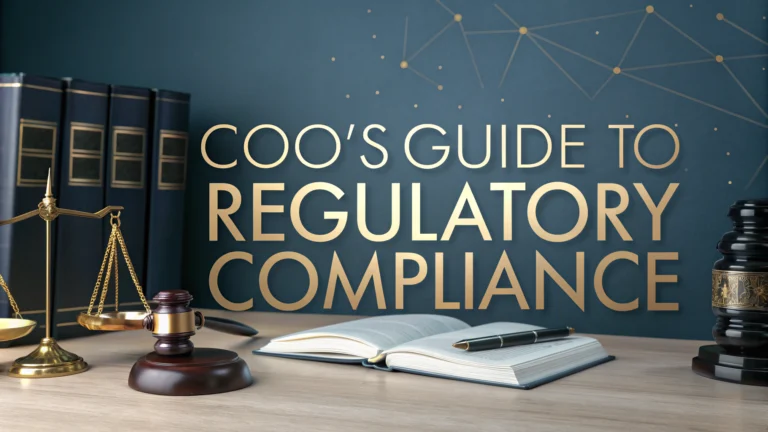A COO’s role in regulatory compliance combines strategic oversight with hands-on implementation of compliance frameworks across the organization.
Meeting regulatory requirements while maintaining operational efficiency requires a balanced approach that protects the organization without hampering growth.
This guide outlines practical steps COOs can take to build and maintain an effective compliance program while managing operational risks.
Key Compliance Areas for COOs
- Industry-specific regulations (HIPAA, GDPR, SOX)
- Environmental compliance
- Workplace safety standards
- Employment law compliance
- Financial reporting requirements
Building Your Compliance Framework
Start with a thorough risk assessment to identify regulatory obligations specific to your industry and operations.
Establish clear policies and procedures that align with identified compliance requirements.
Create a compliance calendar to track deadlines, renewals, and reporting requirements.
Technology and Compliance Management
| Tool Type | Function |
|---|---|
| GRC Platforms | Integrated compliance management |
| Audit Software | Documentation and tracking |
| Training Platforms | Employee compliance education |
Staff Training and Communication
Implement regular compliance training programs for all employees.
Develop clear communication channels for reporting compliance concerns.
Create a culture of compliance through consistent messaging and leadership example.
Monitoring and Reporting
- Establish KPIs for compliance performance
- Regular internal audits
- Documentation systems
- Incident reporting procedures
Working with Regulators
Build positive relationships with regulatory bodies through open communication and prompt responses.
Maintain detailed records of all regulatory interactions and inspections.
Create an action plan for addressing regulatory findings or violations.
Risk Management Integration
Align compliance efforts with enterprise risk management strategies.
Develop contingency plans for potential compliance breaches.
Regular review and updates of risk assessments and controls.
Practical Steps for Success
- Document all compliance processes and procedures
- Maintain updated compliance calendars
- Regular board reporting on compliance status
- Invest in compliance technology solutions
- Build a dedicated compliance team
Moving Forward with Confidence
Schedule quarterly compliance reviews to assess program effectiveness and identify areas for improvement.
Stay current with regulatory changes through industry associations and legal updates.
Consider engaging external compliance consultants for periodic program assessments.
Contact the Association of Corporate Compliance Officers (SCCE) for additional resources and networking opportunities.
Continuous Improvement Strategies
Implement feedback loops to capture insights from compliance activities and incidents.
Regularly benchmark your compliance program against industry standards and best practices.
Use data analytics to identify trends and potential compliance gaps.
Program Assessment Metrics
- Compliance training completion rates
- Incident response times
- Audit findings resolution
- Regulatory reporting accuracy
Cross-Functional Integration
Align compliance initiatives with other business functions including:
- Operations management
- Human resources
- Information technology
- Legal department
Budget and Resource Management
Develop comprehensive budgets for compliance initiatives that account for:
- Technology investments
- Training programs
- External consultants
- Staff resources
Strengthening Your Compliance Foundation
Maintain a proactive stance on regulatory compliance through continuous program evolution and adaptation.
Foster a compliance-aware culture that extends from leadership to front-line employees.
Leverage technology and automation to streamline compliance processes while maintaining effectiveness.
Remember that successful compliance management is an ongoing journey that requires dedication, resources, and organizational commitment.
FAQs
- What are the primary responsibilities of a COO regarding regulatory compliance?
A COO oversees the implementation of compliance programs, ensures adherence to regulatory requirements, develops compliance policies, maintains relationships with regulatory bodies, and coordinates with legal teams to manage compliance risks. - How often should compliance training be conducted for employees?
Compliance training should be conducted at least annually, with additional training sessions when regulations change or new employees join. High-risk areas may require quarterly updates and certifications. - What are the key regulatory frameworks that COOs need to be familiar with?
COOs need to understand Sarbanes-Oxley (SOX), GDPR, industry-specific regulations (like HIPAA for healthcare or Basel III for banking), local labor laws, environmental regulations, and anti-corruption laws like FCPA. - What role does technology play in regulatory compliance management?
Technology enables automated compliance monitoring, risk assessment, documentation management, audit trails, reporting systems, and regulatory change tracking through GRC (Governance, Risk, and Compliance) platforms. - How should a COO handle regulatory audits and inspections?
COOs should maintain updated documentation, establish clear communication channels with auditors, ensure staff preparedness, coordinate responses across departments, and address findings promptly with corrective action plans. - What are the consequences of non-compliance that COOs must be aware of?
Consequences include financial penalties, legal prosecution, license revocation, reputational damage, operational restrictions, mandatory external oversight, and potential personal liability for executives. - How can COOs create an effective compliance monitoring system?
By implementing risk-based monitoring programs, establishing key performance indicators (KPIs), conducting regular internal audits, maintaining compliance dashboards, and utilizing automated monitoring tools. - What should be included in a compliance risk assessment?
Risk assessments should include regulatory requirement mapping, impact analysis, probability assessment, control effectiveness evaluation, gap analysis, and prioritization of compliance risks. - How should COOs manage international regulatory requirements?
COOs must understand local regulations in each operating jurisdiction, maintain relationships with local regulatory bodies, implement country-specific compliance programs, and ensure global consistency while accommodating local variations. - What documentation should COOs maintain for compliance purposes?
Essential documentation includes policies and procedures manuals, training records, audit reports, incident reports, corrective action plans, regulatory correspondence, and compliance meeting minutes.
